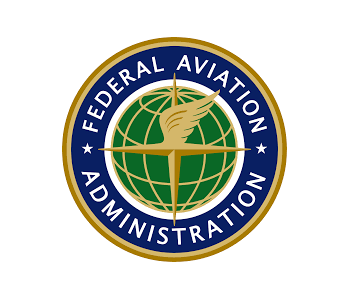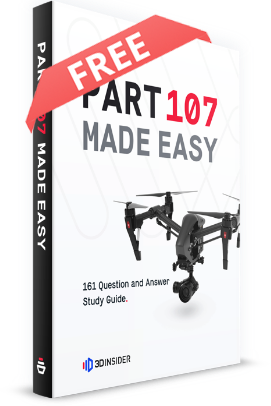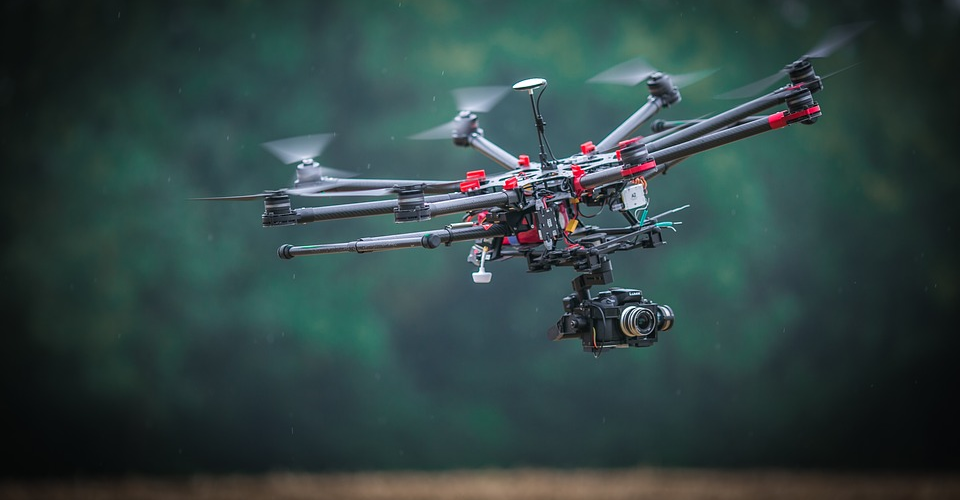Part 107 Changes Will Relax Commercial Drone Flight Restrictions
Drone technology has gone through a lot of changes since the Part 107 rules were first implemented in 2016. As a result, the FAA has recently proposed a few changes to the Part 107 rules and restrictions. What are these proposed changes and how will they affect you as a commercial drone pilot?
What is Part 107?

The Part 107 regulations, which were established more than two years ago, define the operational limits of all kinds of drones. It also required commercial drone pilots to secure a remote pilot certificate, or a Part 107 license, before they can fly their drones for profit.
Before the Part 107 license can be granted, a commercial drone pilot must pass a knowledge test that will test their proficiency on a few different subjects: interpreting sectional charts, radio communications, weather reports, drone maintenance, and troubleshooting. Many drone pilots go to great lengths to prepare for this knowledge test, as it is the single, most difficult part of getting a Part 107 license.
That’s not the end of the story, though. Just like with being granted a driver’s license, being a Part 107 licensed drone pilot means adhering to all the operational limits and documentation requirements as mandated by the FAA. These restrictions include where, when, how fast, and how high you can fly your drone. You will also be required to file accident reports should you get involved in any drone-related accident that resulted in serious personal injury or damage to property.

PART 107 Made Easy
- 161 Question and Answer Study Guide
- 105 pages of illustrated content
- Covers all parts of the Part 107 test
- $97 of value for free
What are the changes proposed by the FAA?
The Part 107 rules have often been criticized for being too restrictive for commercial drone pilots. With the restrictions in place, commercial pilots frequently end up being limited in the types of jobs that they can do. Although the FAA has a system to apply for waivers to some of the Part 107 restrictions, the waiver process is typically slow and overly complicated.
On January 2019, the FAA submitted a “Notice of Proposed Rulemaking” (NPRM) that detailed the changes proposed for the Part 107 rules and regulations. These changes were proposed because of the massive evolution that the drone industry has gone through in the past couple of years. “Today, there are even more applications and opportunities for small UAS that either did not exist or were only in their nascent stages in 2016.”, according to the NPRM document.
Thus, commercial drone pilots will be happy to know that the proposed changes intend to relax the restrictions of the Part 107 rules. The relaxed rules focus primarily on flying drones over non-participating parties and for flying drones at night. We will discuss the details of the proposed new rules in these circumstances below.
1. Flight over people
Under current rules, drone pilots are not allowed to fly their drones over people who are not participating in the drone flight activity. These can include the guests in an event, actors in a movie set, or workers in a construction site being monitored by drone. If you wish to fly a drone under such circumstances, you need to go through the standard route of requesting for a waiver.
The problem with getting a waiver for flying over people is that the burden of proving that the activity can be done safely falls at the shoulders of the drone pilot – specifically how good and experienced they are at drone flight.
Under the proposed changes, the responsibility of proving that a drone can be safely operated over people will shift to the drone manufacturer. Thus, drones need to be classified into one of three categories.
Category 1 drones weigh less than 0.55 lbs. These are considered toy drones or mini-drones and can be safely operated under people. Although there are a few drone models that fall under this category that can be used to moderate-quality drone photography, we don’t expect many professional drone pilots to be flying drones under this weight limit.
Category 2 drones weigh more than 0.55 lbs. but must come with a manufacturer-provided guarantee that a resulting injury by these drones to any person will be under a specified severity threshold. These drones must also have not exposed rotating parts that could cause skin laceration or any FAA-identified safety defect.
Category 3 drones are quite similar to those in Category 2 in that they also must not have any exposed rotating parts and should not have any FA—identified safety defect. However, the specified severity threshold of an accident associated with a Category drone can be higher than what is allowed in Category 2.
Due to the higher severity threshold, there are a few additional stipulations that come with the permission to fly a Category 3 drone over people. It cannot be operated over an open-air assembly of multiple people and must only operated over a closed site or a site with restricted access. Finally, a Category 3 drone must remain in transit when flying over people – it is not allowed to hover in place.
The FAA acknowledges that most commercial drone uses will fall under either Category 2 or Category 3. To identify if a drone is identified in either category, the FAA will maintain a publicly available database of UAV models. To be included in this database, drone manufacturers will need to provide a testing system that exhibits compliance to FAA’s new standards. They will then need to submit a Means of Compliance to the FAA detailing the results of the tests.
2. Flight at nighttime
Flying a drone at night is, by far, the most common waiver application that the FAA has received ever since the enactment of the Part 107 rules. In fact, more than 90% of the waiver applications received by the FAA are for flight at night. During these years, the FAA has reportedly not received a single report of a drone-related accident that happened under the conditions of a nighttime waiver. This has prompted the FAA to propose changes that will allow commercial drone pilots to fly at night without a waiver. Naturally, there are a few requirements such as equipped their drones with anti-collision lights that are visible within up to 3 statute miles.
Another part of this proposal that has more far-reaching consequences is the stipulation that commercial drone pilots need to either undergo training or take an updated knowledge test that will affirm their knowledge related to flying at night.
The FAA has specified that the testing or training that the commercial drone pilots will undergo for flight at night will involve a focus on “night physiology and night illusions.” This particular proposal is very significant, as it has the potential to massively overhaul the certification process to be a Part 107-licensed drone pilot.
3. Additional waiver types
The FAA continues to recognize potential endeavors of commercial drone pilots that could be hampered by Part 107 limitations. To widen the commercial opportunities for these drone pilots, the FAA proposes to offer three additional waiver types, as follows:
- Operations over moving vehicles
- Operations over people that otherwise do not comply with the proposed new rule
- Operations at night without anti-collision lighting
The last two waiver provisions were proposed in the face of the changes that are also being proposed regarding flight over people and at nighttime. There have been no proposed changes in the procedure for securing a waiver and for the corresponding lead-times. Thus we can assume that there will be no changes in these fronts.
4. Authority figures that can request for your remote pilot certificate
According to the original Part 107 rules, a commercial drone pilot may be required to show their remote pilot certificate to an authority figure. However, the rules were not specific as to which authority figures had the capacity to require a drone pilot to show their certificates. The proposed changes make this matter a little clearer by providing a short list of people you may required to show your remote pilot certificate upon request. The list includes:
- The FAA Administrator
- Representatives of the National Transportation and Safety Board (NTSB)
- Any Federal, State, or local law enforcement officer
- Any representative of the Transportation Safety Administration (TSA).
Proposed changes to the certification process
The current process to secure a remote pilot certificate is pretty straightforward: you sign up for the knowledge test and pay the signing fee, pass the test, apply for the certificate, and go through a background check by the TSA. If the background check comes clear, then your remote pilot certificate will be sent in by mail. The Part 107 license is valid for only two years, after which you will need to take a Part 108 recurrent knowledge test. The recurrent knowledge test is quite similar to the original certification test, albeit with a smaller scope of topics as it does not include questions on meteorology and UAV loading and performance.
The proposed changes to the certification process are best summarized in two points:
- Instead of a knowledge test, drone pilots must instead undergo a knowledge training course
- The testing and training materials will be updated to include information about night operations, as well as information on changed regulations
The NPRM also recommends that pilots go through a “recurrent training” every 24 months in place of the recurrent knowledge test. The proposed rule also states that the recurrent training will cover the same topics as the initial knowledge training, in contrast to the reduced scope of the recurrent knowledge test we have right now.
With the proposed changes come a lot of expected questions. The most likely will include: How will the knowledge training be done? Can the trainings be done online? Can the training be provided by done by external parties such as the Drone Pilot Ground School or the Drone Launch Academy? We are asking these questions, as well. However, the FAA has not yet provided any clarifications or details on how these changes will be implemented. Right now, the commercial drone community has no choice but to wait and see.
When will the changes be implemented?
Keep in mind that these changes are currently still in the proposal stage, and there is no assurance yet that they will eventually be implemented. What we do know is that the NPRM was added to the Federal Register on the 13th of February 2019. From that point, the NPRM is subject to public feedback within 60 days.
Page 23 of the NPRM that “the FAA plans to finalize its policy concerning remote identification of small UAS – by way of rulemaking, standards development, or other activities that other federal agencies may propose – before finalizing the proposed changes.” The fact that this is the only passage in the NPRM that indicates when the changes will be implemented is problematic, considering that it relies on a prerequisite policy.
A remote identification policy will greatly enhance safety and accountability among the community of drone pilots. However, the FAA is currently still researching on the best methods to implemented remote identification and unmanned traffic management. Until then, we will not expect these proposed changes to come into effect.
How do the proposed changes affect us?
For the most part, we welcome the greater freedom and flexibility that the proposed changes will give commercial drone pilots. By lessening the circumstances in which a waiver will be needed, commercial drone pilots will be in a better position to accept jobs outside of normal circumstances.
We also embrace the idea of commercial drone pilots going through an authorized training course before being granted a remote pilot certificate. The intent is certainly noble and should result in commercial drone pilots with even higher levels of knowledge and performance.
We are reserving our judgment for the more problematic aspects of these changes, namely the additional time, effort, and money that might be involved in taking the knowledge training. After all, preparing for the knowledge test is already a massive time and money sink. Of course, the FAA could offer a free online course that will satisfy their requirement.
We are also curious how the FAA plans to recompensate the hundreds of testing centers for the loss of income they will incur once the Part 107 knowledge test is discontinued. Right now, it is also still unclear if drone pilots with valid Part 107 licenses will be required to undergo a knowledge training as soon as the changes are implemented.
Final thoughts
We appreciate how the FAA has taken the learnings from the past few years of the implementation of the Part 107 rules and have come up with changes that will address some of the most common gripes. Being able to fly at night without having to apply for a waiver will undoubtedly be a great help to hundreds or thousands of commercial drone pilots. It will also free up the FAA from having to review hundreds of waiver applications of flight at night.
The push to change the certification requirements for Part 107-licensed pilots is a little more controversial. While it would be nice to have a fleet of commercial drone pilots that have been through a standard training program, the time and cost associated with such training might be off-putting for some people. We’re also not sure if the changes will mean that commercial drone pilots with currently valid Part 107 licenses will be forced to “start over” and take the knowledge training right away to maintain their licenses.
As to when the proposed changes will take effect – who knows? It could be a while, considering that the FAA will wait until there is a remote identification policy in place. Considering how these things go, we are probably looking 1.5 to 2 years before we can expect a policy change.
If you have any opinions on the FAA’s proposed changes to the Part 107 rules, then just sound off below.


